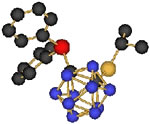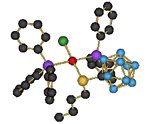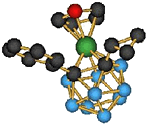
The Teixidor’s research group is interested in working with dicarba-closo-dodecaborane C2B10H10. One of the capital features of these carboranes is the capability of the 2 carbon atoms and 10 boron atoms to adopt the icosahedral geometry in which the carbon and boron atoms are hexacoordinated.

The acidity of both hydrogen atoms connected directly to the carbon atoms in comparation to the other exo-cluster hydrogen atoms, leads to their substitution with heteroatoms as S, Se, P and Si. So it has been reported the synthesis of monothio and dithiocarboranes with cyclic and acyclic chain, mono and di-phosphino carboranes. Recently has been reported mixed carboranes in which one carbon atom is substituted by sulfur and the second by phosphorus atoms. These new carboranes incorporating mixed groups were the result of the development of a new method to synthesize monosubstituted carboranes, this implies the substitution of only one carbon atom leaving the other C-H bond intact.
Inspite of the thermal and chemical stability of the 1,2-dicarba-closo-dodecaborane, this can be deboronated using MOH/alcohol, M= alkaline metal. This solution removes one boron atom and forms the ion 7,8-dicarba-nido-undecaborate (1-). As a result the nido-carboranes derivatives were obtained.
 In order to know the properties of these type of compounds, reaction of these nido carborane derivatives toward transition metals has been studied in our group. These ligands generally coordinate to the metal via S and/or P. Additional B-H-M bond has been found in the case of monothio and monophosphino derivatives. In their complexes the normal coordination number of the metal ion is usually maintained.
In order to know the properties of these type of compounds, reaction of these nido carborane derivatives toward transition metals has been studied in our group. These ligands generally coordinate to the metal via S and/or P. Additional B-H-M bond has been found in the case of monothio and monophosphino derivatives. In their complexes the normal coordination number of the metal ion is usually maintained.
It has also been demonstrated that in the case of the disubstituted closo carborane derivatives with S or P and S/P mixed carboranes, a double reaction has been found: deboronation of the cluster and its coordination to the metal leading to the correspondent metallacarboranes.
 As has been indicated above, closo-carborane can be deboronated by removing one boron atom. Starting from the nido-dithio carborane derivatives [C2B9H10(SR)2]–, dianionic species [C2B9H9(SR)2]2- can be obtained by proton abstraction. As a result a number of “sandwich” derivatives analogues to the transition metal cyclopentadienide derivatives, to say bis(dicarbollide)metallacarborane containing C-SR bonds have been obtained
As has been indicated above, closo-carborane can be deboronated by removing one boron atom. Starting from the nido-dithio carborane derivatives [C2B9H10(SR)2]–, dianionic species [C2B9H9(SR)2]2- can be obtained by proton abstraction. As a result a number of “sandwich” derivatives analogues to the transition metal cyclopentadienide derivatives, to say bis(dicarbollide)metallacarborane containing C-SR bonds have been obtained
 It has also been reported in our group for the first time carbon substituted derivatives of [3,3′-Co(1-Me-2-R-1,2-C2B9H9)]– incorporating lipophilic chains. Extraction tests have been carried out for 137Cs, 90Sr and 152Eu from nuclear wastes. Recently our group has reported another family of mixed cobalta sandwich compounds incorporating pyrrole [NC4H4]– and the dicarbollide cluster [C2B9H11]2-.
It has also been reported in our group for the first time carbon substituted derivatives of [3,3′-Co(1-Me-2-R-1,2-C2B9H9)]– incorporating lipophilic chains. Extraction tests have been carried out for 137Cs, 90Sr and 152Eu from nuclear wastes. Recently our group has reported another family of mixed cobalta sandwich compounds incorporating pyrrole [NC4H4]– and the dicarbollide cluster [C2B9H11]2-.
Selected Publications:
1. “A Novel Rh-B Bond. Crystal Structure of [N(CH3)4][RhCl{7,8-m-S(CH2CH2)S-C2B9H10}{-7,8-m-S(CH2CH2)S-C2B9H9}]”.
Journal of the Chemical Society, Chemical Communications, 192, (1991).
F. Teixidor, A. Romerosa, C. Viñas, J. Rius, C. Miravitlles and J. Casabó.
2. “Simultaneous Conversion of Pd-PPh3 and B-H to B-PPh2 Under Exceedingly Mild Conditions. Crystal and Molecular Structure of PdPPh3Cl{7-SMe-8-Me-11-PPh2-7,8-C2B9H10}”.
Journal of the American Chemical Society, (1991), 113, 9895-9896.
F. Teixidor, J. Casabó, A.M. Romerosa, C. Viñas, J. Rius and C. Miravitlles.
3. “Silver Coordination to Exo-dithio-7,8-dicarba-nido-undecaborate Derivatives. Sulphur to Metal and Open Face to Metal: Two Ways of Bonding”.
Journal of the Chemical Society, Chemical Communications, 1279, (1992) .
F. Teixidor, J.A. Ayllón, C. Viñas, J. Rius, C. Miravitlles and J. Casabó
4. “A novel B-H-Ru Agostic Bond. Crystal Struture of [RuCl{7,8-,m-S(CH2CH2)S-C2B9H10}(PPh3)2]·CH3OCH3“
Journal of the Chemical Society, Chemical Communications, 1281, (1992).
F. Teixidor, J.A. Ayllon, C. Viñas, R. Kivekäs, R. Sillanpää and J. Casabó.
5. “[Rh{7-SPh-8-Me-7,8-C2B9H10]: A New Type of Rhodacarborane with Enhanced Activity in the Hydrogenation of 1-Alquenes”.
AngewandteChemie, 108, 2388, (1996); Angewandte Chemie, International Edition in English, 1996, 35, 2251 .
F. Teixidor, M.A. Flores, C. Viñas, R. Kivekas and R. Sillanpää.
6. “Exo-nido- cyclooctadienerhodacarboranes: Synthesis, reactivity and catalytic properties in alkene hydrogenation”.
Journal of American Chemical Society, 122, 1963, (2000) .
F. Teixidor, M.A. Flores, C. Viñas, R. Sillanpää and R. Kivekäs.
7. “The distinct effect of the o -carboranyl fragment. It’s influence on the I-I distance in R3PI2 complexes”
Angewandte Chemie International Edition, 39, 23, 4290, (2000); Angewandte Chemie, 2000, 112, 4460 .
F. Teixidor, R. Nuñez, C. Viñas, R. Sillanpää and R. Kivekäs.
8. “ The Modulating Possibilities of Dicarbollide Clusters. Optimizing the Kharasch Catalysts”
Journal of the American Chemical Society, 125, 11830, (2003); DOI: 10.1021/ja036342x.
O. Tutusaus, C. Viñas, R. Núñez, F. Teixidor, A. Demonceau, S. Delfosse, A.F. Noels, I. Mata and E. Molins.
9. “Relevance of the electronegativity of boron in η5 coordinating ligands. regioselective monoalkylation and monoarylation in cobaltabisdicarbollide [3,3′-Co(1,2-C2B9H11)2]– clusters”.
Chmistry A European Journal, 9, 18, 4311, (2003) .
I. Rojo, F. Teixidor, C. Viñas, R. Kivekäs and R. Sillanpää.
10. “Neutral nido-heteroboranes with non ionisable hydrogen as arenes in coordination”
Chemical Communication, 2458, (2003) .
O. Tutusaus, C. Viñas, R. Kivekäs, R. Sillanpää and F. Teixidor.
11. “Generation of bridging alkene and conjugated dialkenes on the [3,3′-Co(1,2-C2B9H11)2]– platform exclusively generated from alkynes. The unique hydroboration role of [3,3′-Co(1,2-C2B9H11)2]–“
Journal of the American Chemical Society, 125, 14720, (2003) . DOI: 10.1021/ja037279e
I. Rojo, F. Teixidor, R. Kivekäs, R. Sillanpää and C. Viñas
12. “Synthesis and coordinating abity of an anionic cobaltabisdicarbollide ligand geometrically analogous to BINAP”.
Chemistry a European Journal , 10, 5376 (2004). DOI: 10.1002/chem. 200400361
I. Rojo, F. Teixidor, C. Viñas, R. Kivekäs and R. Sillanpää.
13. “Restricted Rotation in Un-bridged Sandwich Complexes. Rotational Behavior of closo [Co(η5-NC4H4)(C2B9H11)] derivatives”.
Chemistry A European Journal , 2005, 11, 1939, DOI: 10.1002/chem.200400445
J. Llop, C. Viñas, F. Teixidor, R. Sillanpää and R. Kivekäs.
14. “Regioselective synthesis of 6-monoalkylderivatives of [1-CB9H10]– from dicarba-closo-dodecaboranes”.
Angewandte Chemie, 2005, 44(15), 2220-2222.
F. Teixidor, A. Laromaine and C. Viñas.
15. “Highly stable neutral and positively charged dicarbollide sandwich complexes”.
R. Núñez, O. Tutusaus, F. Teixidor, C. Viñas, R. Sillanpää, R. Kivekäs.
Chemistry A European Journal , in press.
16. “Strikingly long C···C distances in 1,2-disubstituted ortho-carboranes and their dianions”.
J. M. Oliva, N. L. Allan, P. v. R. Schleyer, F. Teixidor, C. Viñas.
Journal of the American Chemical Society, accepted.
17. “Are methyl groups electron-donating or electron-withdrawing in boron clusters?. Permethylation of o-carborane”
Francesc Teixidor, Gemma Barberà, Albert Vaca, Raikko Kivekäs, Reijo Sillanpää, Clara Viñas, and Josep Oliva
Journal of the American Chemical Society, 2005, 127, 10158-10159. DOI: 10.1021/ja052981r .
